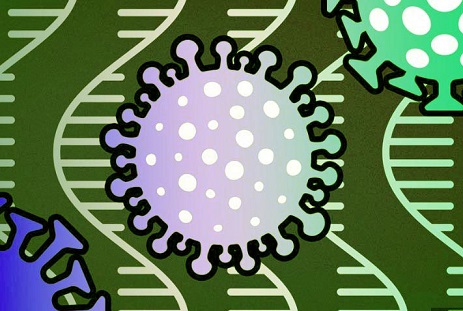Nikhil Prasad Fact checked by:Thailand Medical News Team Sep 09, 2024 7 months, 2 weeks, 3 days, 6 hours, 11 minutes ago
As SARS-CoV-2 continues to evolve, it has become evident that certain aspects of the virus are changing rapidly, while others remain relatively stable. A new study conducted by researchers from Corewell Health, Grand Rapids, and Michigan State University in the United States, highlights the unique challenge posed by the continuous drift of the virus's spike protein. This
Medical News report delves into these findings, focusing on how the spike protein’s evolution is affecting the virus's behavior and potential treatments.
 SARS-CoV-2 genotyping sheds light on the challenges of spike protein drift
The Focus on Spike Protein
SARS-CoV-2 genotyping sheds light on the challenges of spike protein drift
The Focus on Spike Protein
The spike protein, a crucial component of SARS-CoV-2, plays a vital role in enabling the virus to infect human cells by binding to the ACE2 receptor. The drift of this protein has raised significant concerns, as it directly impacts vaccine efficacy and the virus's ability to evade immunity.
Unlike many other viral proteins, the spike protein undergoes frequent mutations, which make it difficult to develop long-lasting vaccines and treatments.
The study team set out to understand how this drift in the spike protein is occurring and what implications it has for global health efforts. Through a two-year genotyping window and structural biology analysis, the team investigated how selective pressures are driving changes in the virus's spike protein while leaving other essential proteins largely intact. The study brings new insights into how these changes are shaping the future of SARS-CoV-2 management.
Key Study Findings
One of the most notable findings of the study is that while the spike protein exhibits a high rate of drift, other SARS-CoV-2 proteins, such as nsp7, nsp14, and nsp5, remain remarkably stable. These proteins, which are essential for viral replication and transcription, have undergone very few changes over the last two years. This stability presents an opportunity for drug development, as targeting these proteins could lead to more sustainable antiviral therapies that are less susceptible to the rapid mutation of the virus.
The study reveals that the spike protein, which is heavily targeted by vaccines and immune responses, experiences significant amino acid changes, especially in regions involved in antibody evasion and ACE2 receptor binding. These changes allow the virus to maintain its ability to infect human cells while evading immunity, leading to the continued circulation of new variants.
Despite the ongoing drift, the researchers found that certain regions of the spike protein, particularly those responsible for binding to the ACE2 receptor, remain functionally conserved. This means that even though the virus is changing, it still retains its ability to enter human cells, albeit with subtle adjustments that help it avoid detection by the immune system.
Implications for Vaccine and Drug Development
The findings of this study have significant implications for the future of vaccine and drug development. The high rate o
f spike protein drift suggests that vaccines targeting this protein may require regular updates to keep up with new variants. This iterative process of vaccine development, already seen with the annual flu shot, is likely to become a common approach in the fight against COVID-19.
However, the researchers suggest that alternative strategies may be necessary to complement spike protein-targeted vaccines. Targeting the virus's more stable proteins, such as nsp7 and nsp5, could provide a more reliable approach to antiviral drug development. These proteins are crucial for the virus's replication machinery, and because they do not mutate as frequently, drugs targeting them could remain effective over a longer period. The stability of nsp5 makes it an attractive target for future drug development.
Challenges in Spike Protein-Targeted Therapies
While targeting the spike protein has been the primary focus of vaccine development efforts, the study highlights the limitations of this approach. The ongoing drift of the spike protein presents a moving target for vaccine developers, with each new variant requiring modifications to existing vaccines. Moreover, the selective pressure exerted by vaccines and immune responses may be driving further changes in the virus, potentially increasing its transmissibility or virulence.
The researchers caution that this evolutionary arms race between the virus and immune responses could lead to unforeseen consequences. As the virus continues to adapt, it may become more adept at evading immunity, making it harder to control outbreaks. This suggests that future vaccine strategies may need to take a more holistic approach, targeting multiple viral proteins to prevent the virus from evolving around a single therapeutic target.
The Need for Protein-Centric Genotyping
One of the key takeaways from the study is the need for a more protein-centric approach to genotyping. While much of the focus during the pandemic has been on genomic changes at the RNA level, the study shows that these changes do not always translate into functional changes in the virus's proteins. By focusing on the stability of viral proteins, researchers can gain a better understanding of how the virus evolves and how to develop more effective treatments.
The study's authors argue that more attention should be paid to the virus's non-spike proteins, which are often overlooked in favor of the more visible spike protein. These proteins, including nsp7, nsp14, and nsp5, play critical roles in the virus's replication and survival, making them prime targets for antiviral drugs.
Conclusion
The study findings offer new insights into the evolution of SARS-CoV-2 and the challenges of spike protein drift. While the spike protein remains a key target for vaccines and immune responses, the ongoing drift of this protein highlights the need for complementary approaches that target the virus's more stable proteins. This multi-pronged approach to vaccine and drug development could provide a more effective long-term strategy for managing COVID-19 as it continues to circulate globally.
The study findings were published in the peer-reviewed journal: Microorganisms.
https://www.mdpi.com/2076-2607/12/9/1863
For the latest COVID-19 News, keep on logging to Thailand
Medical News.
Read Also:
https://www.thailandmedical.news/news/covid-19-news-more-mpro-mutations-emerging-on-newer-sars-cov-2-variants-are-current-antivirals-still-effective
https://www.thailandmedical.news/news/breaking-sars-cov-2-ba-2-variant-spawning-mutations-on-its-mpro-sites-that-reduce-efficacy-of-the-antiviral-paxlovid-many-such-variants-in-america-no 